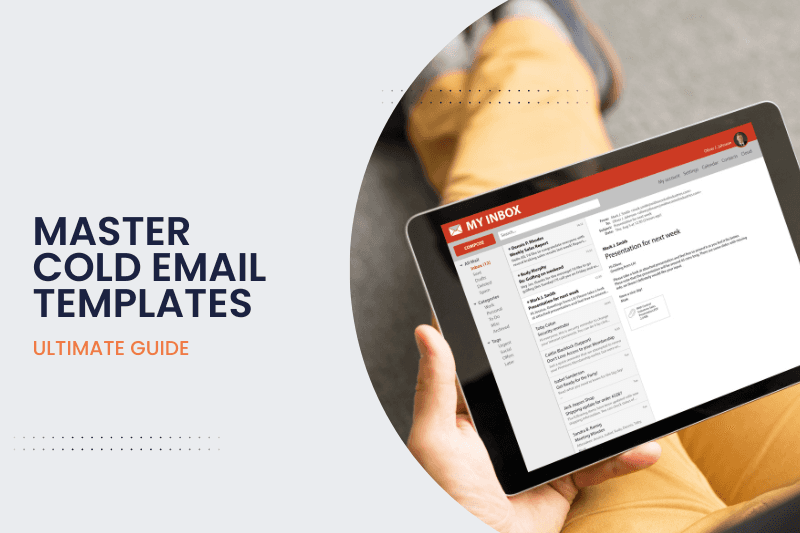Cold Email
Master Cold Email Templates: Your Ultimate Guide
Learn to create attention-grabbing, personalized, and clear messages. Utilize concise calls-to-action and proper formatting to improve response rates. This guide offers strategies for crafting effective emails and optimizing campaigns.
Dec 15, 2023

Crafting the perfect cold email can feel like trying to find a needle in a haystack. But what if you had a map of that needle? That's exactly what you'll get with our ultimate guide to cold email templates.
You'll learn how to grab attention, evoke interest, and prompt action—all with the power of a well-crafted email. Whether you're reaching out to potential clients, pitching to investors, or just trying to network, the right template can make all the difference.
Say goodbye to the guesswork and hello to the results.
The Importance of Cold Email Templates
When you're diving into the art of cold emailing, cold email templates are your secret weapon.
They’re not just placeholders with fancy fonts and colors; they're battle-tested formulas that can drastically improve your outreach efforts.
Increase Response Rates
Imagine sending hundreds of emails and hearing nothing but crickets. That’s the fear, right? But here’s the good news: cold email templates boost your chances of a reply.
Why? Because they are:
Attention-Grabbing: A well-crafted template makes your email stand out in a crowded inbox.
Personalized: Templates allow for personalization, showing recipients you know who they are.
Clear and Concise: You get to deliver your message without rambling, making it easier for your recipient to respond.
Making sure your cold email templates hit these marks increases the likelihood of engagement from potential clients or investors.
Think of it like a bow; you've got one shot—so make it count.
Save Time and Effort
You're busy. You've got a business to run, calls to make, and maybe even a dog to walk. Crafting an individual email for each prospect is an impossible task.
Here's where cold email templates save the day:
Streamlined Process: Create once, use repeatedly. No need to reinvent the wheel with every email.
Consistency: You establish a consistent voice and brand presence across all your outreach efforts.
Measurable: Templates make it easier to track what works and what doesn’t for continuous improvement.
By investing the initial effort into creating impactful cold email templates, you save more time for other important tasks. You can spend fewer hours in your inbox and more on growing your business.
Remember, templates are meant to be a starting point. They provide a skeleton for your message, but your knack for personalization and relevance fills in the flesh.
With cold email templates, you can propel your outreach strategy and watch your response rates and productivity soar.
Creating an Effective Cold Email Template
1. Understand Your Target Audience
Before you dive into the world of cold email templates, it's crucial to understand who you're emailing.
Are they business executives or creative professionals? What are their pain points, and how can your offer address those?
Knowing this helps tailor your message to match their interests and needs.
2. Personalize Your Emails
Generic messages are a dime a dozen, and your recipients can sniff them out in a second. Use data points like name, company, and industry-specific references to make your messages feel personal.
Personalization goes beyond the mere mention of a name; it's about showing that you've done your research and understand their unique situation.
3. Use a Clear and Compelling Subject Line
The subject line is your first—and often only—chance to make an impression. Make sure it's both clear and compelling.
A great subject line guides recipients to open the email out of curiosity or because they believe it'll benefit them.
4. Keep Your Email Concise and to the Point
Time is precious, and nobody wants to sift through a rambling message. Keep your cold email templates short, delivering value in the fewest words possible.
Highlight your main points in a clear, uncluttered manner.
5. Include a Call to Action
What do you want the recipient to do after reading your email? Be it scheduling a call, signing up for a demo, or simply replying, your call to action should be blatant and easy to find.
A clear CTA increases the chances of receiving a response.
6. Use Proper Formatting and Grammar
First impressions last. If your email is riddled with errors or is a large block of text, it's likely to be ignored. Proper formatting and grammar are non-negotiable for professional communication.
Break text into short paragraphs, use bullet points for easy skimming, and definitely triple-check for typos.
Cold Email Template Examples
Putting together effective cold email templates can be the cornerstone of your outreach strategy.
Below, you’ll find sample templates that can be adapted for different purposes.
Each template serves as a starting point; tailor them to fit your brand voice and the unique traits of your recipient.
Template 1: Introduction Email
In your introduction email, the goal is to make a connection without sounding like a generic sales pitch.
Here's a simplified template:
Subject: Quick Question for [Recipient’s Name]
Hi [Recipient’s Name],
I recently came across [their company name] and noticed [something admirable about their work/company]. I believe there’s a great chance for us to collaborate.
I’m with [Your Company], and we specialize in [your unique selling proposition]. Our clients typically see [specific benefit].
Would you be open to a brief chat on how we can help [their company] achieve [specific goal or solve a problem]? Let me know when you're available this week for a quick call.
Best regards, [Your Name]
Template 2: Product/Service Offer
Craft a value-packed offer that clearly demonstrates the benefits of your product or service.
An example could be:
Subject: Enhance Your [Recipient’s Industry] Operations with [Your Product/Service]
Hi [Recipient’s Name],
Are you struggling with [pain point] in your business?
At [Your Company], we have developed a [product/service] that tackles this problem head-on. Our [product/service] has helped clients like [Client Name] boost [specific metric] by [percentage].
To show you exactly how it works, I’d love to offer you [an exclusive offer or trial].
Could we schedule a call this week to discuss this further?
Best, [Your Name]
Template 3: Follow-Up Email
The follow-up email is essential to remind the recipient of your previous communication and prompt a response.
Here’s an approach to consider:
Subject: Re: [Previous Subject Line] - Checking In
Hi [Recipient’s Name],
I wanted to touch base regarding my last email about [your offer or the reason for the initial email]. I understand you’re busy, but I believe our [product/service] could really benefit [their company].
If you have any questions or need further details, I’m more than happy to chat at a time that suits you. Could we pencil in a time this week?
Looking forward to hearing from you.
Warm regards, [Your Name]
When using these cold email templates, remember to personalize your interactions with each prospect.
Solid research on your prospect’s business can make or break your campaign's success. Keep tracking your emails' performance and adjust your approach accordingly.
A/B Testing and Optimization
When you've got your cold email templates ready to go, don't just send them out en masse. Instead, take a strategic approach to ensuring your emails hit the mark through A/B testing, also known as split testing.
1. Split Testing Your Templates
A/B testing is a way to compare two versions of a single variable to see which one performs better.
Here's how to split-test your cold email templates:
Draft two versions of your email, changing one element at a time.
Segment your email list and send version A to one segment and version B to another.
Keep a close eye on key performance indicators like open rates and click-through rates.
It's crucial not to alter more than one variable between the two versions so you can pinpoint exactly what's causing any changes in performance.
Test different subject lines, email bodies, call to action, or even the time of day you're sending out emails.
2. Analyzing Results and Making Improvements
Once you've collected enough data from your A/B test, it's time to dive into the results. Look for statistically significant differences between the two sets. What worked? What didn’t?
Use these insights to refine your cold email templates:
If one subject line gets more open, use it in future campaigns.
Analyze which email body resonated more by looking at the time spent on your email or the click-through rate.
Consider your target audience's preferences based on the response rates.
Remember to implement changes based on your findings and continually use A/B testing to iterate and improve your cold email template performance.
By doing so, you'll be able to craft messages that truly engage your prospects and improve your chances of getting a response.
Best Practices for Cold Emailing
When crafting cold email templates, it's vital to abide by best practices that not only enhance the potential of your campaign but also build a solid foundation for business communication.
1. Build a Quality Email List
Building a top-notch email list is your first step. A refined list ensures your cold emails hit the mark:
Target the Right Audience: Identify prospects that align with your business profile.
Verify Email Addresses: Use email verification tools to keep your list clean and bounce rates low.
Segment Your Contacts: Tailor your outreach by grouping similar prospects together. This strategy enhances personalization and response rates.
2. Follow Regulations and Best Practices
Staying within legal bounds while following email etiquette is crucial:
Abide by CAN-SPAM Act: This act sets rules for commercial emailing. Make sure you offer a clear opt-out mechanism.
GDPR Compliance: For EU citizens, ensure your practices align with GDPR standards.
Deliver Value in Your Emails: Your emails should offer clear, concise benefits to the recipients.
3. Track and Analyze Email Performance
Understanding how your cold email templates perform is key to your strategy:
Monitor Open Rates: This metric offers insight into how compelling your subject lines are.
Check Click-Through Rates: High CTRs indicate that your message resonates with recipients.
Keep an Eye on Response Rates: A direct indicator of engagement. Low response rates may mean your call-to-action needs tweaking.
4. Continuously Test and Improve
The only way to perfect your cold emailing technique is through incessant testing and enhancement:
A/B Testing: Experiment with various elements of your cold email templates to see what works best.
Iterate Based on Feedback: Respondent feedback can be a goldmine for improving your emails.
Stay Updated with Trends: Email marketing trends evolve, so it's critical to stay informed and adapt your strategies accordingly.
Each step of your cold emailing process should be meticulously planned and executed, from how you build your email list to how you interpret the success of your campaigns.
By marrying the art of personal interaction with the science of data analytics, you're poised to create cold email templates that not only captivate but also convert.
Conclusion
Crafting the perfect cold email template isn't just about the words you write—it's about the strategy behind them. Remember to personalize your approach, adhere to industry regulations, and keep an eye on those crucial metrics.
Testing and refining your emails will help you stay ahead of the curve, ensuring your messages resonate with your audience. With these tips in hand, you're well on your way to mastering the art of cold emailing and driving meaningful results for your business.
So go ahead, apply what you've learned, and watch as your efforts yield the connections and conversions you're aiming for.

